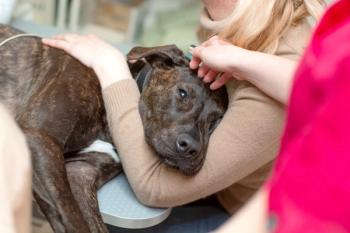
Raw Chicken Associated With Paralysis in Dogs
Researchers have found a link between canine consumption of raw chicken and an increased risk of developing acute polyradiculoneuritis, a peripheral nerve disorder that can lead to paralysis.
More data have emerged that underlines the possible
In a study published in the
About Acute Polyradiculoneuritis
APN is a rare immune-mediated peripheral nerve disorder found primarily in dogs, in which the immune system becomes unregulated and attacks its own nerve roots. The debilitating and sometimes fatal condition begins in a dog’s hind legs and worsens progressively over several days to affect the dog’s front legs, neck, head, and face. “Some dogs may die from the disease if their chest becomes paralyzed,” said Matthias le Chevoir, DVM, DECVN, head of neurology for the university and chief investigator of the study. In most cases, however, dogs recover.
RELATED:
- Raw Food Diets: High Risk and Little Reward
- The Danger Lurking in Raw Pet Foods
APN is considered the canine counterpart of Guillain-Barré syndrome (GBS) in humans, a condition that also causes the body’s immune system to attack its nerves. In up to 40% of GBS patients, Campylobacter is considered a triggering agent and is believed to be present in undercooked chicken, unpasteurized milk products, and contaminated water.
“Our team at U-Vet Animal Hospital wanted to understand if consuming raw chicken could also be triggering APN in dogs,” Dr. le Chevoir told the university’s research website,
Study Parameters
Between March 2015 and February 2017, researchers studied 27 client-owned dogs with signs of APN—changes in voice, hind limb weakness, or a choppy gait—and 47 dogs without.
Fecal samples were collected from each enrolled dog to perform direct culture, DNA extraction, and polymerase chain reaction for detection of Campylobacter. Additional data were obtained from medical records and owner questionnaires in both groups, with a focus on the consumption of raw chicken meat. Owners of 96% of the dogs with APN reported raw chicken consumption, compared with 26% of owners of control dogs. No analysis was conducted of the raw chicken fed to the dogs with APN signs because the owners could not provide samples.
Results
Fecal samples from 13 of the 27 dogs with APN tested positive for Campylobacter compared with 11 of 47 samples in the control group, making dogs with APN 9.4 times more likely to have had a Campylobacter infection. The authors wrote that within the study, consumption of raw chicken was strongly associated with the occurrence of APN.
“The microbe Campylobacter is likely to be the reason for the dysregulation of the dogs’ immunity and the symptoms of paralysis,” said Lorena Martinez-Antòn, DVM, one of the study’s coauthors. “These bacteriological results were consistent with the hypothesis that the uncooked chicken meat was the source of the Campylobacter and as a result, triggered APN.”
Newsletter
From exam room tips to practice management insights, get trusted veterinary news delivered straight to your inbox—subscribe to dvm360.




